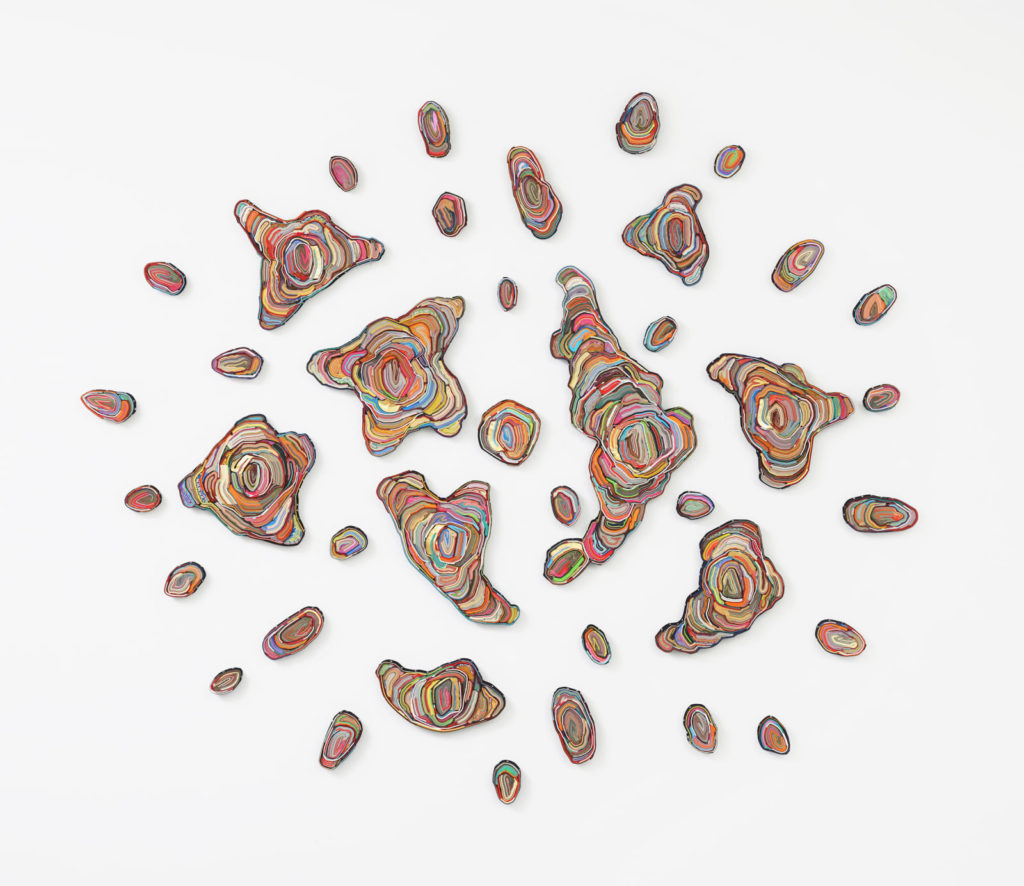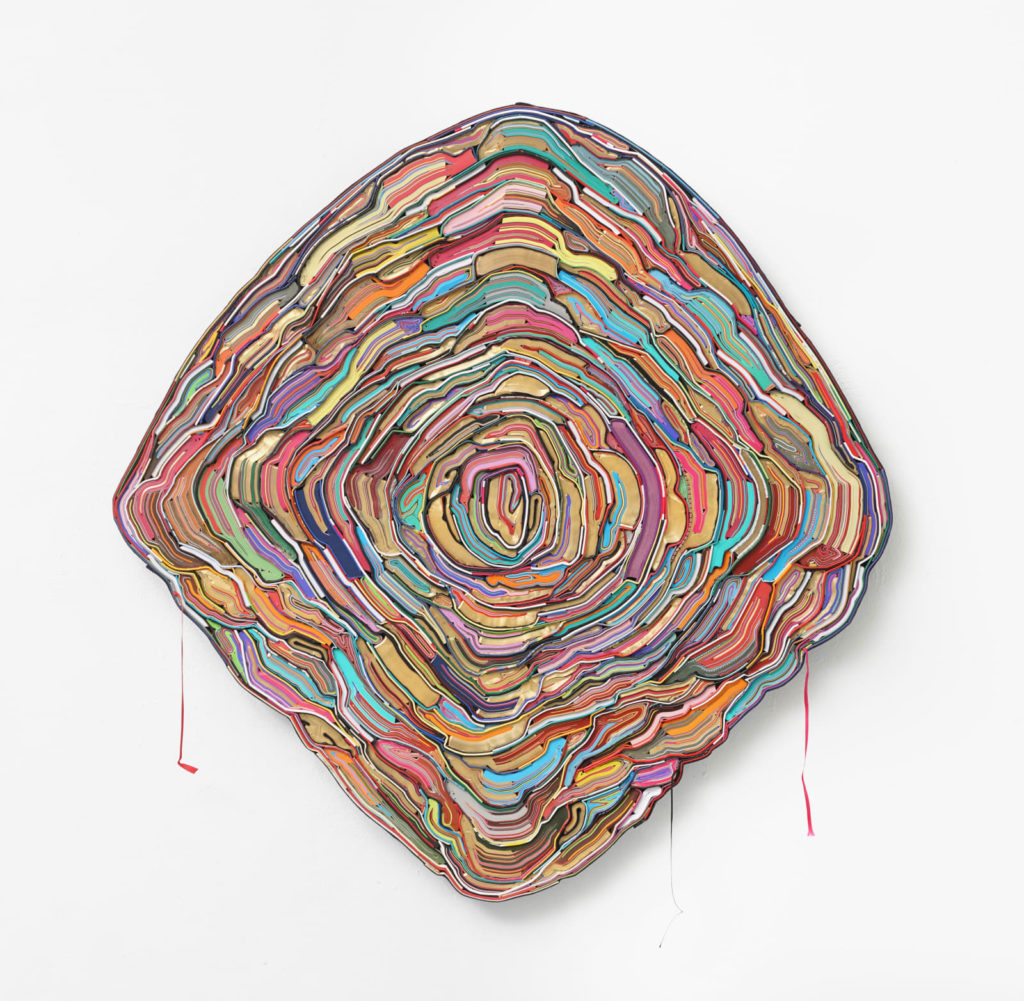Meet the artist: François du Plessis
Get to know South African artist François du Plessis and his incredible book objects.

Introducing artist François du Plessis, the campaign artist for Affordable Art Fair, Austin (May 16 – 19, 2024). Known for his book objects, François du Plessis is represented by the internationally renowned Chiefs & Spirits Gallery.
We met François to learn more about his journey in becoming an artist and the innovative way in which he uses brightly coloured books to create his characterful works.
INTERVIEW WITH FRANÇOIS DU PLESSIS
What is the inspiration behind your work?
I’m interested in forms and colours and the aesthetic of nature is the thing that inspires me the most. You might notice that a lot of my works look like tree stumps.
I love walking through the forest and take photos of all interesting organic forms. For me all forms in nature are perfect. In contrast to the conscious striving of a linear progress in society, nature doesn’t always have a choice, as trees can’t decide how they grow.
It’s the mixture of both, the inner energy and the outer influences which create the perfection in nature to me.

Who are some of your main influences when it comes to your creative process?
I don’t really have any main influences as such, but as my artistic roots lie in painting, I like artists such as Gerhard Richter, Rembrandt and Van Gogh; the way they painted and dealt with light, perspective and colours, especially.
I’m also impressed by Robert Rauschenberg’s oeuvre and the variety of media he used, such as found objects, assemblage, and painting.
Do you feel that being born in Zimbabwe and growing up in South Africa influenced your work?
Yes, it definitely did, as I already incorporated a lot of found objects into my paintings back then. I used a lot of earthy colours as well as very bright colours, which you can still see in my book objects today.
In South Africa, I was always fascinated by the Ndebele women in my city of Pretoria in their traditional dresses; colourful blankets, neckbraces, arm and leg braces. Some of these aspects certainly influenced me later, as they’re still very much in the back of my mind, especially the colours and found objects.

Materiality seems central to your work – do you have a sense of where and when that interest started for you?
Materiality is central to my work, and this comes from me growing up in South Africa partly on a farm between the ages of 13 and 18. I always collected strange and interesting pieces of wood or withered pieces of metal, wire etc. and either carved and painted them. Some of them I gave away to my friends and family or, incorporated them into my paintings/assemblages, back then when I was still a painter.
The book objects that I create today are, basically, also found objects that have a materiality and colour range that inspire me as if I were still a painter.
Can you tell us more about how you decide which books to use?
I use books I receive as gifts or I buy them in a book store close to where I live, or in book stores when I visit other cities. To collect them became like an addiction to me. The coloured edges are most interesting to me when I’m in the process of deciding which books I use for my book objects, as I don’t paint them at all. Some of the edges are printed with words and, for example, the golden colours often come from the edges of hymn books.
The literary content of the books doesn’t matter to me when I create the objects, only it’s forms and colours. The only content of the books which is left, is when I use the title of a book as the title of the artwork.

Can you tell us about your journey to the arts? Have you always wanted to become an artist?
As a child, I drew on every possible piece of paper I could get my hands on; be it my mom’s monthly magazines, my dad’s daily newspaper or my school books. However, I never knew that I’d be an artist later in life, and also never studied art. I always just did it whenever I had time.
Back in South Africa, I was a musician, playing the drums. At the age of 24, I left South Africa as I wanted to see the big wide world and didn’t want to live in the military and apartheid regime anymore. After travelling through Europe and the Middle East for 3 years, I applied for political asylum in Germany and worked as a carpenter for some years.
Roughly 25 years ago, I thought it would be lovely to do art more seriously and got myself a studio. It has been a long journey in reaching the point where I was able to earn money with it to pay my bills and to become an established artist. You have to be disciplined, but it is something I love to do and it’s what gives me a lot of freedom.


As an artist what does a typical day look like for you?
I’m an early bird. In Summer, I’m in my studio by 8am and in Winter, a bit later as it’s darker in the morning. I work until 2-5pm, go home, check my mails, meet friends, and recap what I did in my studio. My studio is a peaceful place to me, where I feel good, like home. I usually have the music on very loud, listening to all different kinds of genres but mostly to rock or punk-rock. I play music myself, as a drummer in a ska and reggae band.
What would you say are the most rewarding and the most challenging aspects of being an artist today?
The most rewarding aspect of being an artist today is doing the thing you love most and being able to earn a living from it. I’d never want to change it for anything else in the world. The most challenging aspect of being an artist is that one hopes there will always be buyers for one’s art. I’m an optimist.
What does the Affordable Art Fair represent for you? What do you enjoy about the fair?
The Affordable Art Fair for me is a platform that showcases an artist’s work not necessarily just in one city but, across multiple cities and countries and that’s great for an artist. I also very much enjoy the friendliness of the fair teams and galleries.
We hope you enjoyed reading about François du Plessis’ practice. Follow us on instagram for more updates on the upcoming Austin Fair to see his work IRL!
